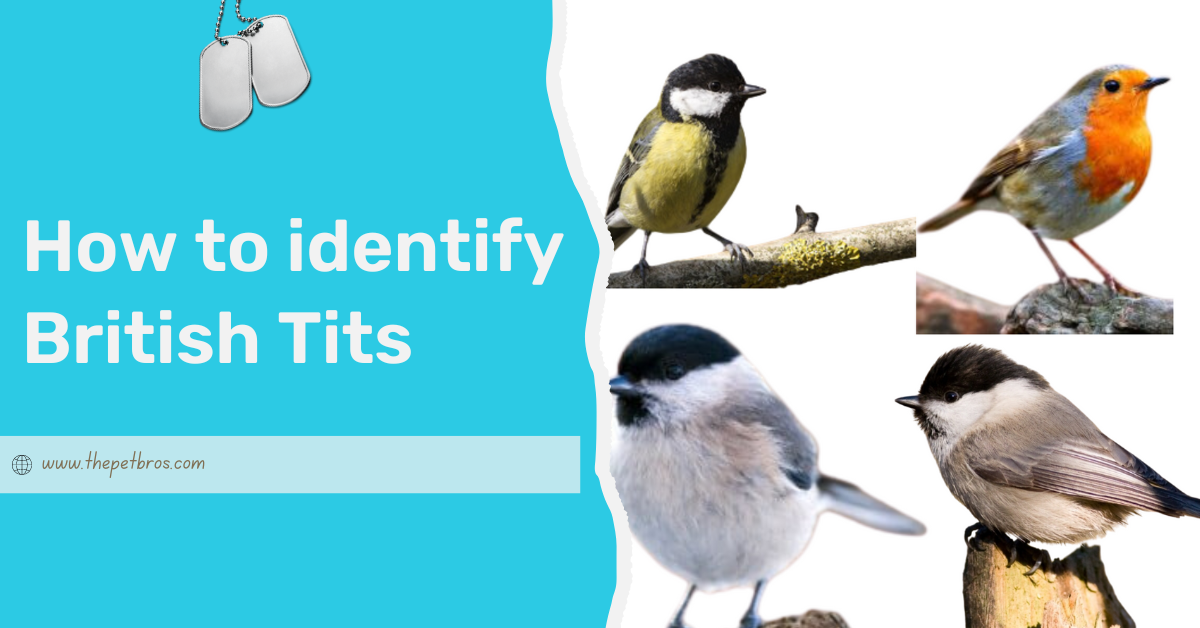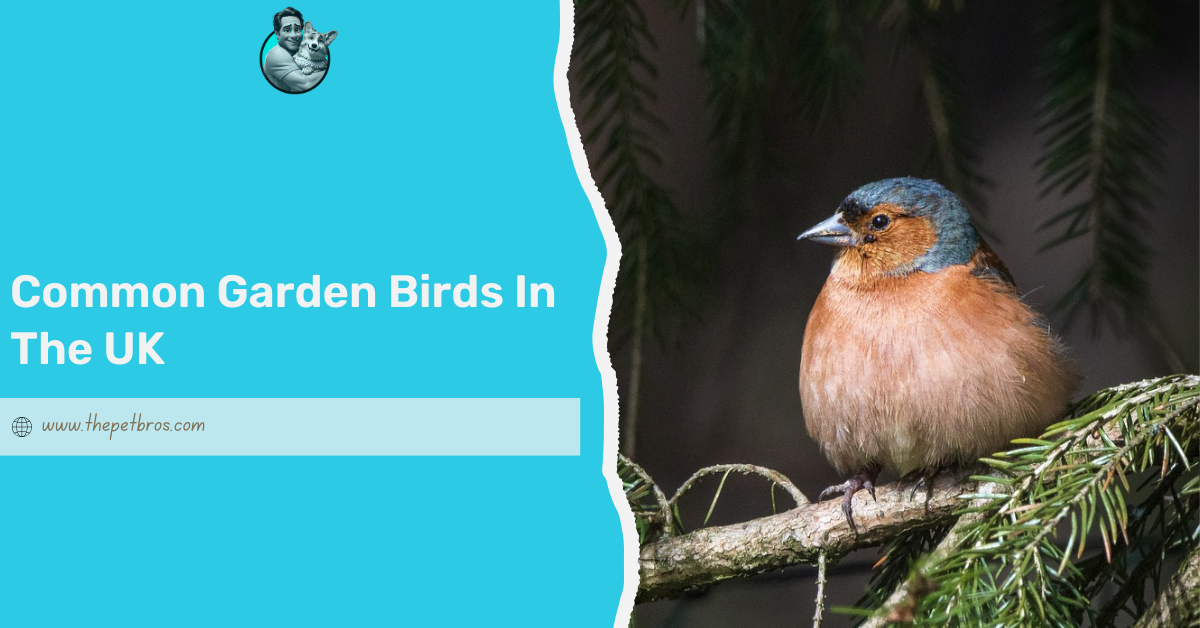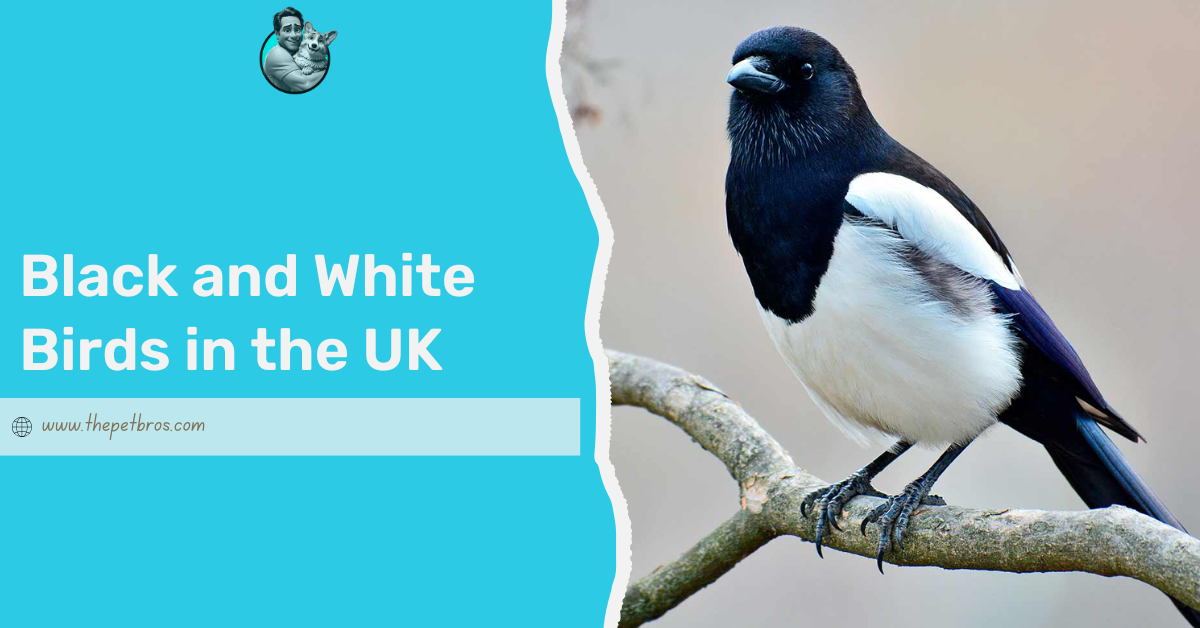Imagine sipping your morning tea, glancing out the window, and catching a glimpse of a small, brightly coloured bird flitting around the garden. You know it’s a tit, but which one? If you’ve ever found yourself caught between guessing the species of these delightful little garden visitors, you’re in the right place. In this article, we’ll break down exactly how to identify British tits by their appearance, behaviour, distinctive calls, and so on, so you can confidently tell a blue tit from a great tit in no time. Let’s get right into it!
How to Identify Common Tits in the UK
There are only about six to seven species of tits found in the UK, each, of course, with its own distinct features:
- Blue Tit
- Great Tit
- Coal Tit
- Long-Tailed Tit
- Marsh Tit
- Willow Tit
- Crested Tit (mainly found in the Scottish Highlands)
In the following sections, we’ll walk you through how to identify British tits, discussing them one after the other:
How to Identify the Blue Tit
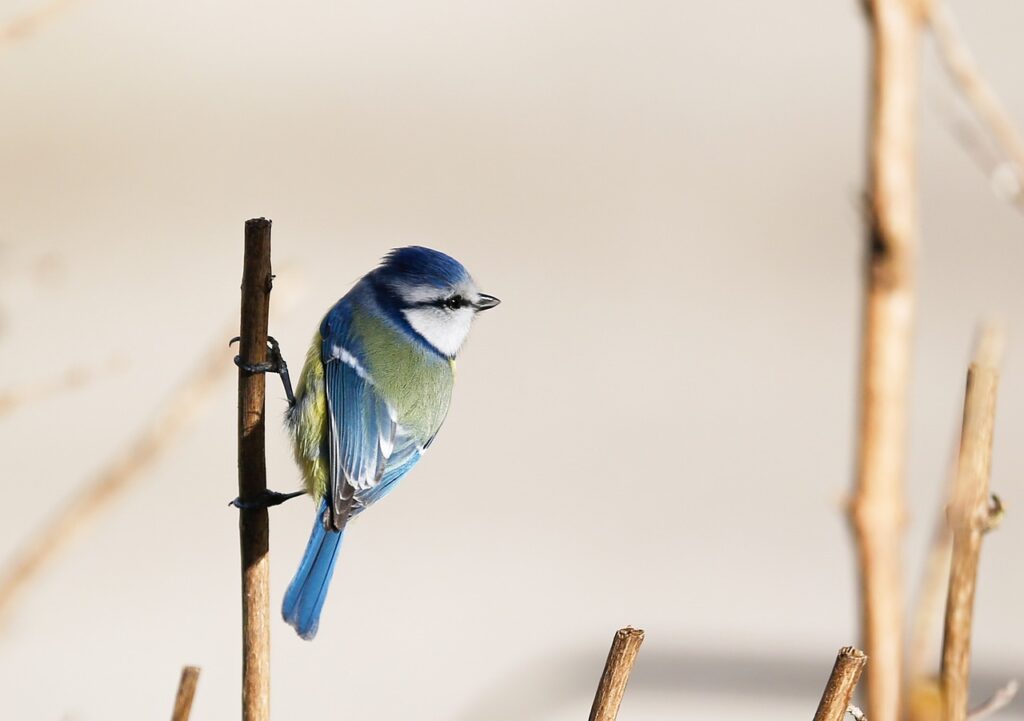
| Features | Blue Tit |
| Appearance | Bright blue cap, yellow belly, green back, white face with dark blue line across eyes |
| Size | Around 12 cm, wingspan of 18 cm |
| Call/Song | High-pitched “tsee-tsee-tsee,” varied cheerful trills. |
| Behaviour | Acrobatic, energetic, problem-solving, frequent at feeders |
| Diet | Insects, seeds, nuts, fat balls, sunflower seeds |
The blue Tit (Cyanistes caeruleus) is one of the most recognisable and beloved garden birds in the UK. Its vibrant colours and acrobatic behaviour give it out, especially when it’s darting between feeders or perching on branches.
Interestingly, the blue Tit’s striking combination of colours is its most distinctive feature. It has a bright blue cap, wings, and tail, contrasted by a yellow belly and greenish back. Its face is primarily white, with a thin dark blue line running across the eye and around the face, somewhat making it appear like a masquerade.
Although it is categorised as a small bird in the UK, the boldness of its colours often makes it stand out among other small birds, especially during the spring and summer months when they are most active. Blue tits measure around 12 cm in length, with a wingspan of approximately 18 cm.
Blue tits have a lively, high-pitched call, often described as a rapid “tsee-tsee-tsee.” Their song is varied and cheerful. Being familiar with the blue Tit’s calls can be a helpful tool for those learning how to identify British tits by sound, especially when several species share the same habitat.
Overall, blue tits are energetic and inquisitive, and you will typically find blue tits building nests in tree holes or bird boxes, using moss, feathers, and wool to create a cosy environment for their young.
They are also known for their intelligence and problem-solving abilities, often being the first to figure out how to access difficult-to-reach food sources. Blue tits have a diet consisting mainly of insects, seeds, and nuts. They are especially fond of fat balls and sunflower seeds, which provide them with essential energy, particularly during colder months.
How to Identify the Great Tit
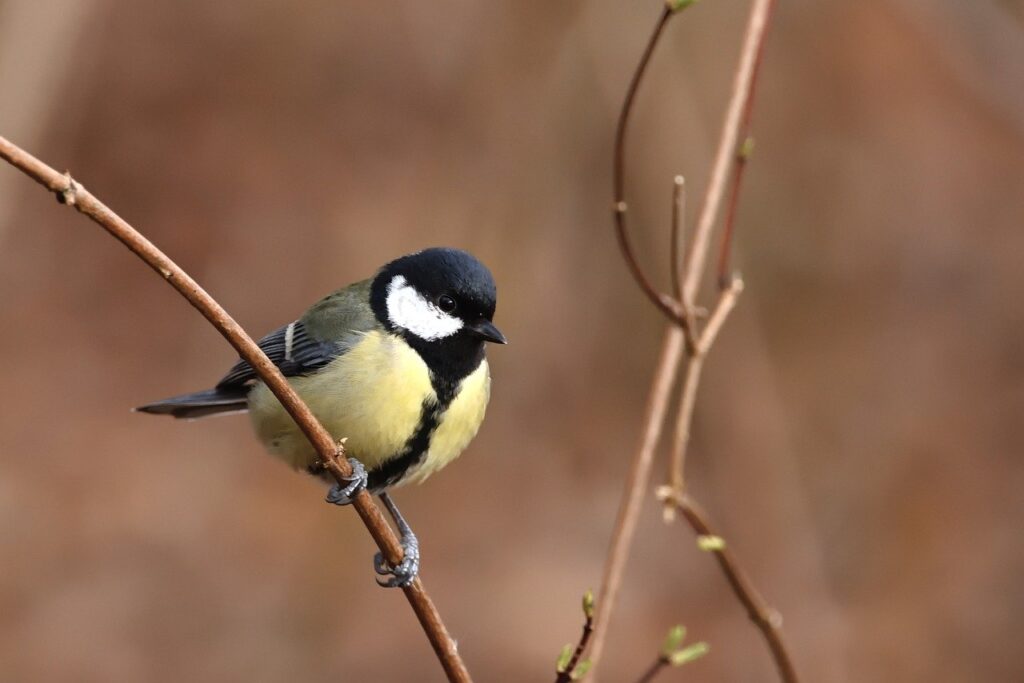
| Features | Great Tit |
| Appearance | Black head, white cheeks, yellow belly with black stripe, olive-green back |
| Size | Around 14 cm, wingspan of 24 cm |
| Call/Song | Two-note “tea-cher, tea-cher,” variety of chattering sounds |
| Behaviour | Bold, dominant at feeders, territorial, thrives in both urban and rural settings |
| Diet | Insects, seeds, nuts, suet, peanuts, sunflower seeds |
The great Tit (Parus major) is the largest and one of the boldest of the UK’s tit species, measuring about 14 cm in length with a wingspan of roughly 24 cm. And like the blue tits, they also have striking colours that make them easy to recognise.
Great tits have a distinctive black head and white cheeks alongside a vibrant yellow breast with a bold black stripe down the middle. This is usually what people always notice first. However, the males tend to have a thicker black stripe compared to females.
The bird’s back is a soft olive green, and its wings feature a mix of black, white, and greenish tones, creating a striking contrast.
One of the most memorable aspects of the great Tit is its call. The bird’s song is a clear, repetitive two-note whistle, often described as “tea-cher, tea-cher.” Beyond this call, great tits are capable of a variety of sounds, from chattering to sharp, high-pitched notes. Recognising these vocalisations is key to mastering how to identify British tits by sound, especially in dense woodlands where tits might be harder to spot.
Great tits are typically dominant and are not shy about chasing off smaller birds to claim their place at the table. Their fearless nature is particularly evident during the breeding season when they fiercely defend their territory. Unlike some of the more timid tit species, great tits thrive in both rural and urban settings, making them one of the most adaptable tit species in the UK.
Great tits feast on insects, seeds, and nuts throughout the year. During the colder months, they become frequent visitors to garden feeders, where they favour high-energy foods like suet, peanuts, and sunflower seeds.
How to Identify the Coal Tit
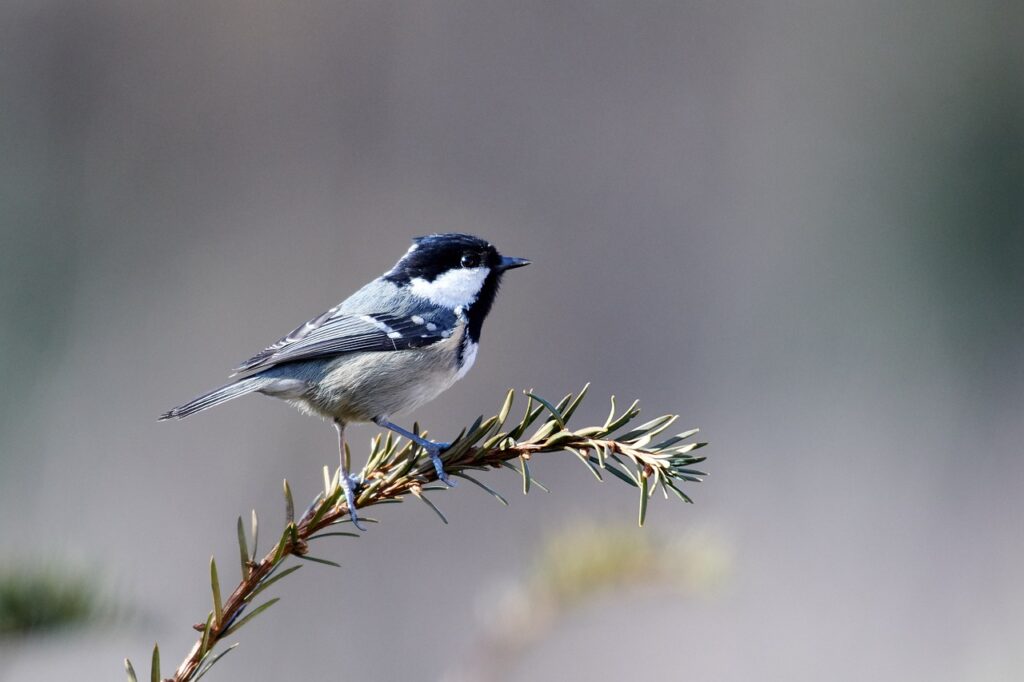
| Features | Coal Tit |
| Appearance | Black cap, white patch on the back of the head, grey upperparts, two white wing bars |
| Size | Around 11.5 cm, wingspan of 17 cm |
| Call/Song | High-pitched “pee-pee-pee,” rapid series of sharp notes |
| Behaviour | Energetic, food-caching behaviour, frequently found in coniferous forests and woodland. |
| Diet | Insects, seeds, small nuts, sunflower hearts |
The coal tit (Periparus ater) is arguably one of the smallest tit species in the UK. Its subtle appearance can make it easy to overlook at first, but once you know the key features, you’ll be able to spot this busy little bird with ease.
The coal tit has a black cap, which extends down its neck, and a contrasting white patch on the back of its head. Unlike the blue Tit or great Tit with bright colours, the coal tit’s colours are calmer, with greyish upperparts and pale buff underparts. Coal tits have wings marked with two distinctive white wing bars, which are particularly noticeable when the bird is in flight.
If you think the blue Tit is small, then you haven’t seen the coal tit, which is only 11.5 cm long. Yeah, it’s pretty small! However, despite its small size, it is very energetic, although not energetically acrobatic like the Blue Tit. Coal tits are fast, nimble, and constantly on the move.
The coal tit has a high-pitched call, often described as a soft “pee-pee-pee.” The coal tit’s vocalisations are subtler than its larger relatives, but if you listen closely, you will hear them clearly.
Now, they have a unique behaviour: coal tits often cache food, hiding seeds in crevices to eat later, especially during winter months. Their diet includes insects, seeds, and small nuts, and if you want to attract coal tits to your garden, consider providing smaller seeds, such as sunflower hearts, which are easier for them to handle.
Lastly, their ability to adapt to different environments makes them one of the more widespread species in the UK.
How to Identify the Long-Tailed Tit
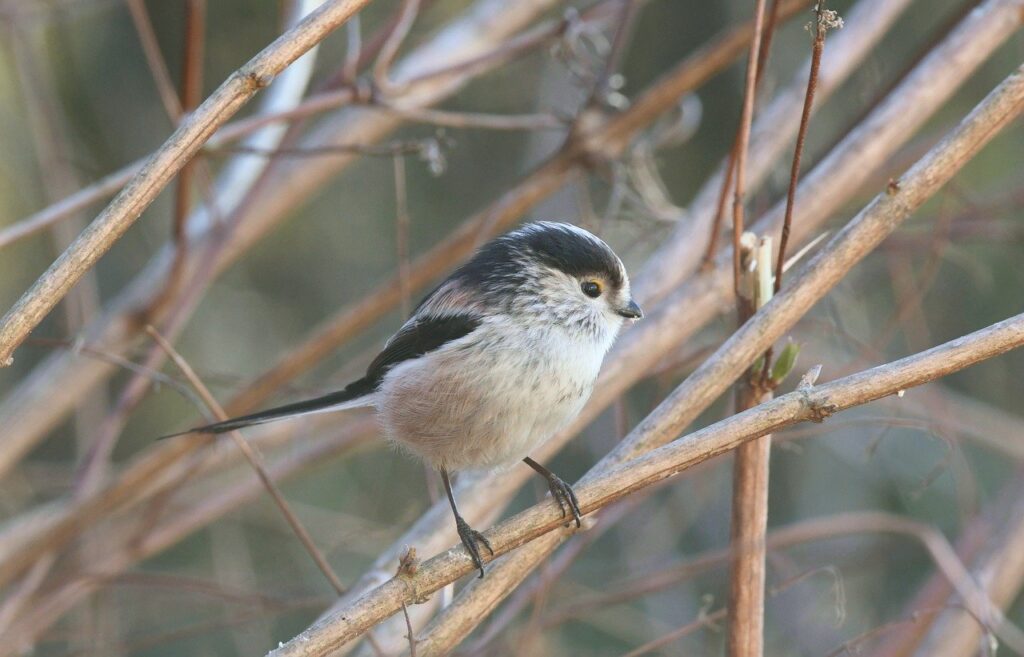
| Feature | Long-Tailed Tit |
| Appearance | Tiny, round body, black-and-white long tail, pinkish flanks, pale face |
| Size | Around 15 cm total (8-9 cm body, 7-8 cm tail), wingspan of 16-18 cm |
| Call/Song | Soft, high-pitched “tsirr, tsirr” sounds |
| Behaviour | Social, moves in flocks, constantly on the move, quick and agile |
| Diet | Insects, spiders, seeds, fat balls |
As its name suggests, the long-tailed Tit (Aegithalos caudatus) is indeed long-tailed. It features a tiny, almost spherical body and an exceptionally long black-and-white tail, which is almost twice the length of its body. The bird’s face is pale, with a faint black “mask” across the eyes, and it is known for its charming, social nature. This bird is often seen in small flocks, flitting about trees and shrubs.
However, despite its long tail, the body of the long-tailed Tit is remarkably small, only around 8-9 cm in length, but the tail can add another 7-8 cm, making the total length around 15 cm. They are gentle tit birds and are known for their quiet, high-pitched calls, often heard as soft, conversational “tsirr, tsirr” sounds as they move through trees. Their calls are generally less varied and more delicate than those of other tits, but they are constant communicators within their flocks.
Long-tailed tits are constantly on the move, feeding on insects and spiders. In the winter, their diet expands to include seeds and fat balls, which is why they are frequent visitors to garden feeders in colder months.
How to Identify the Marsh Tit
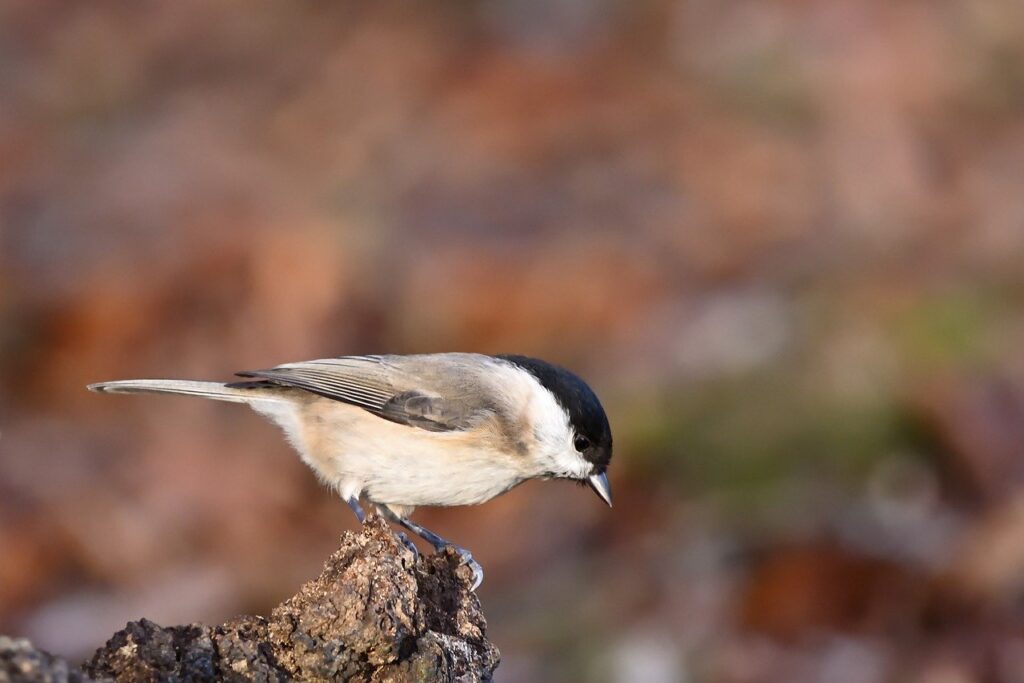
| Feature | Marsh Tit |
| Appearance | Glossy black cap, pale face, buff underparts, grey-brown upperparts |
| Size | Around 12 cm, wingspan of 19 cm |
| Call/Song | Sharp “pitchoo,” rapid, high-pitched notes |
| Behaviour | Shy, prefers woodlands and hedgerows, less common at feeders |
| Diet | Insects, seeds, berries, nuts |
The marsh tit (Poecile palustris) is a more elusive tit bird and is often confused with its close relative, the willow tit. For birdwatchers or intending tit bird owners learning how to identify British tits, distinguishing between the marsh and willow tit can be one of the trickier challenges. However, despite the similarity in appearance, there are subtle differences that help in identifying the marsh tit once you know what to look for.
First, the marsh tit is a small, understated bird with a glossy black cap and a pale face. Its underparts are buff-coloured, while its upper parts are a soft greyish-brown. One of the key ways to tell it apart from the willow tit is the marsh tit’s glossier cap and the lack of a pale wing panel.
Its overall appearance is delicate and somewhat plain, but its smooth cap and subtle colouring help set it apart in the right light. The marsh tit measures about 12 cm in length with a wingspan of approximately 19 cm. They have a sharp, high-pitched “pitchoo” sound. Unlike their subtle appearance, their voice is loud!
Ironically, unlike its name suggests, the marsh tit doesn’t typically frequent marshy areas. Instead, it prefers deciduous woodlands, hedgerows, and dense foliage. This shy and elusive bird tends to avoid gardens, making it a less common sight at feeders compared to other species. Like other type of tits, marsh tits have a varied diet that includes insects, seeds, and berries.
How to Identify the Willow Tit

| Feature | Willow Tit |
| Appearance | Dull black cap, pale wing panel, buff underparts, grey-brown upperparts |
| Size | Around 12 cm, wingspan of 18-19 cm |
| Call/Song | Harsh “zwee-zwee,” repetitive and nasal |
| Behaviour | Shy, prefers damp woodland and hedgerows, excavates its own nesting holes. |
| Diet | Insects, seeds, berries, fat balls |
As mentioned earlier, the willow tit (Poecile montanus) is often mistaken for its close relative, the marsh tit, due to its very similar appearance. However, the willow tit is a rare and declining species in the UK. Therefore, if you think you’ve seen a willow tit, chances are, you actually saw a marsh tit. But, of course, any article on how to identify British tits is incomplete if the willow tit is left out. So, here we are…
Like the marsh tit, the willow tit has a black cap and pale face. However, its black cap is duller and less glossy, giving it a more matte look. Additionally, the willow tit has a slightly larger, more rounded head and features a pale wing panel that is absent in the marsh tit. Its overall colouration is buff with greyish-brown upper parts.
The willow tit is nearly identical in size to the marsh tit. However, their call is significantly different and is considered the most reliable way to differentiate the two birds. Willow tits have a harsh, nasal “zwee-zwee” sound. Willow tits also tend to have a more repetitive song with fewer variations.
The willow tit is a shy and elusive bird and tends to excavate its own nesting holes in decaying wood, a rare trait among tit species. This behaviour sets it apart from the marsh tit, which typically uses existing cavities for nesting.
The willow tit’s diet is similar to other tit species, feeding on insects, seeds, and small berries.
How to Identify the Crested Tit
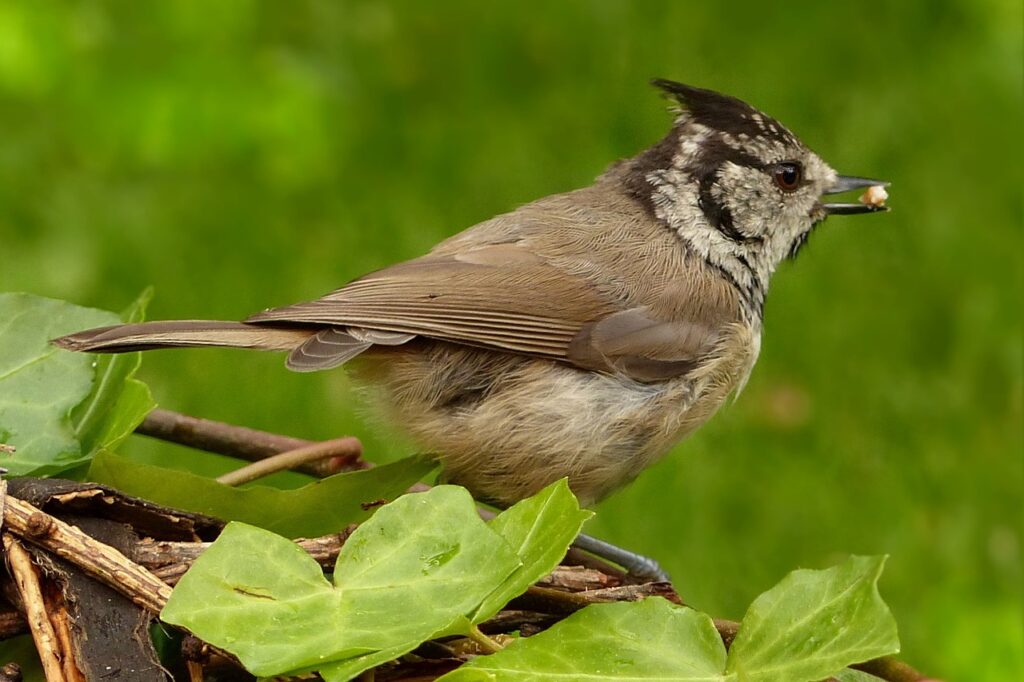
| Feature | Crested Tit |
| Appearance | Prominent black-and-white crest, greyish-brown body, black eye stripe, white cheeks |
| Size | Around 11-12 cm, wingspan of 17-20 cm |
| Call/Song | Harsh “trrrr-trrrr,” rapid series of short, high-pitched notes |
| Behaviour | Secretive, prefers coniferous forests, forages for pine seeds |
| Diet | Insects, spiders, seeds, pine seeds, peanuts, fat balls |
Lastly, we have the crested Tit (Lophophanes cristatus). The crested Tit is also very rare in the UK and is commonly found in the pine forests of the Scottish Highlands. It has a distinctive black-and-white crest on its head and bold markings, with a primarily greyish-brown body with pale underparts and a black eye stripe running through its white cheeks.
The crested Tit is medium-sized compared to other tits. It has a harsh “trrrr-trrrr” sound, often likened to the rattle of a woodpecker. Its song is a quick series of short, high-pitched notes, often delivered in rapid succession, especially when it’s high up in trees and difficult to spot.
Unlike other tit species, which may be bold or social, the crested Tit tends to be more secretive, often moving quietly through the trees. They also have a varied diet and feed on insects, spiders, and seeds. In the autumn and winter, it also consumes large quantities of pine seeds and will occasionally visit garden feeders in its native range, particularly if high-energy foods like peanuts or fat balls are available.
Conclusion
As a pet owner, whether you have a cat, dog, or even a bird, British tits can bring even more joy and energy to your garden. But how do you get the desired one if you do not know how to identify British tits in the first place? Anyway, by reading this article till this point, identifying British tits must now be a breeze!
Not sure if tit birds are the right choice for your garden? Then you may want to explore other common British birds to consider!






